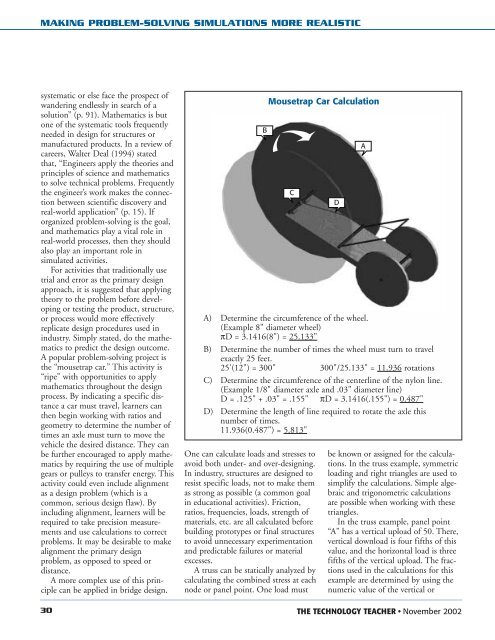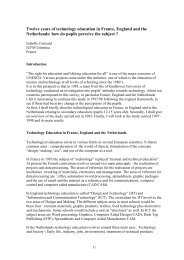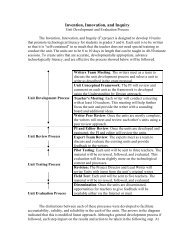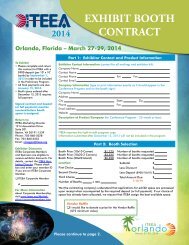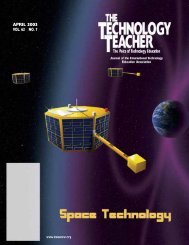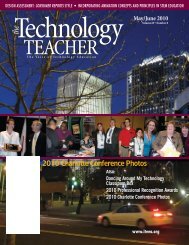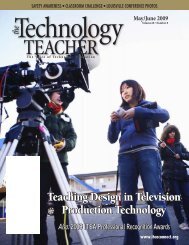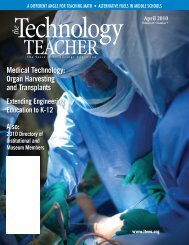NOVEMBER 2002 VOL. 62 NO. 3 - International Technology and ...
NOVEMBER 2002 VOL. 62 NO. 3 - International Technology and ...
NOVEMBER 2002 VOL. 62 NO. 3 - International Technology and ...
- No tags were found...
You also want an ePaper? Increase the reach of your titles
YUMPU automatically turns print PDFs into web optimized ePapers that Google loves.
MAKING PROBLEM-SOLVING SIMULATIONS MORE REALISTICsystematic or else face the prospect ofw<strong>and</strong>ering endlessly in search of asolution” (p. 91). Mathematics is butone of the systematic tools frequentlyneeded in design for structures ormanufactured products. In a review ofcareers, Walter Deal (1994) statedthat, “Engineers apply the theories <strong>and</strong>principles of science <strong>and</strong> mathematicsto solve technical problems. Frequentlythe engineer’s work makes the connectionbetween scientific discovery <strong>and</strong>real-world application” (p. 15). Iforganized problem-solving is the goal,<strong>and</strong> mathematics play a vital role inreal-world processes, then they shouldalso play an important role insimulated activities.For activities that traditionally usetrial <strong>and</strong> error as the primary designapproach, it is suggested that applyingtheory to the problem before developingor testing the product, structure,or process would more effectivelyreplicate design procedures used inindustry. Simply stated, do the mathematicsto predict the design outcome.A popular problem-solving project isthe “mousetrap car.” This activity is“ripe” with opportunities to applymathematics throughout the designprocess. By indicating a specific distancea car must travel, learners canthen begin working with ratios <strong>and</strong>geometry to determine the number oftimes an axle must turn to move thevehicle the desired distance. They canbe further encouraged to apply mathematicsby requiring the use of multiplegears or pulleys to transfer energy. Thisactivity could even include alignmentas a design problem (which is acommon, serious design flaw). Byincluding alignment, learners will berequired to take precision measurements<strong>and</strong> use calculations to correctproblems. It may be desirable to makealignment the primary designproblem, as opposed to speed ordistance.A more complex use of this principlecan be applied in bridge design.30One can calculate loads <strong>and</strong> stresses toavoid both under- <strong>and</strong> over-designing.In industry, structures are designed toresist specific loads, not to make themas strong as possible (a common goalin educational activities). Friction,ratios, frequencies, loads, strength ofmaterials, etc. are all calculated beforebuilding prototypes or final structuresto avoid unnecessary experimentation<strong>and</strong> predictable failures or materialexcesses.A truss can be statically analyzed bycalculating the combined stress at eachnode or panel point. One load mustBMousetrap Car CalculationCA) Determine the circumference of the wheel.(Example 8" diameter wheel)πD = 3.1416(8") = 25.133"B) Determine the number of times the wheel must turn to travelexactly 25 feet.25'(12") = 300" 300"/25.133" = 11.936 rotationsC) Determine the circumference of the centerline of the nylon line.(Example 1/8" diameter axle <strong>and</strong> .03" diameter line)D = .125" + .03" = .155" πD = 3.1416(.155") = 0.487"D) Determine the length of line required to rotate the axle thisnumber of times.11.936(0.487") = 5.813"DAbe known or assigned for the calculations.In the truss example, symmetricloading <strong>and</strong> right triangles are used tosimplify the calculations. Simple algebraic<strong>and</strong> trigonometric calculationsare possible when working with thesetriangles.In the truss example, panel point“A” has a vertical upload of 50. There,vertical download is four fifths of thisvalue, <strong>and</strong> the horizontal load is threefifths of the vertical upload. The fractionsused in the calculations for thisexample are determined by using thenumeric value of the vertical orTHE TECH<strong>NO</strong>LOGY TEACHER • November <strong>2002</strong>


